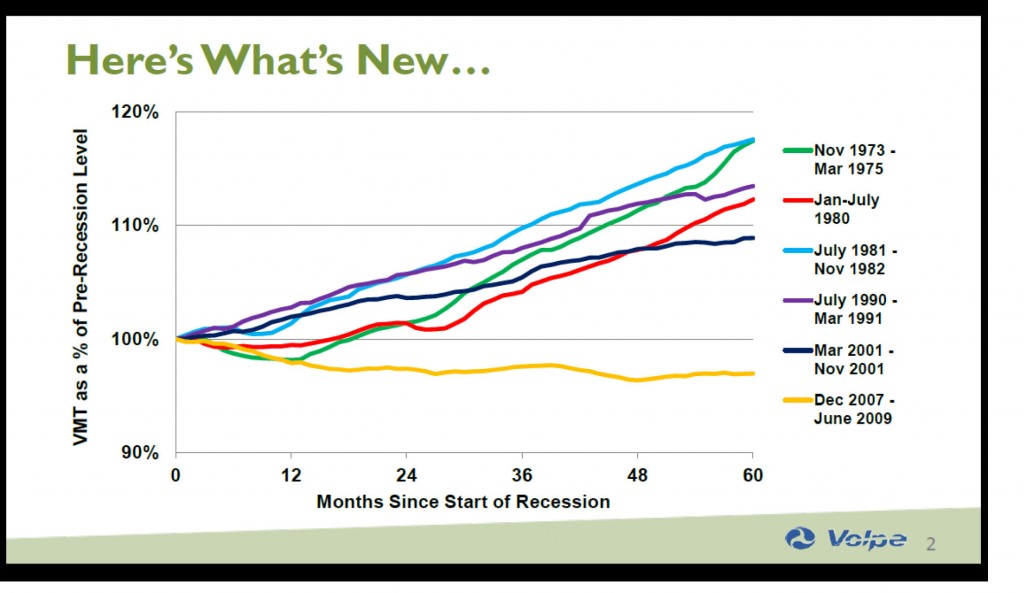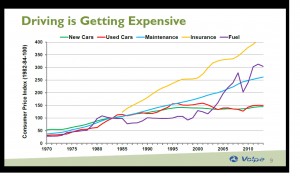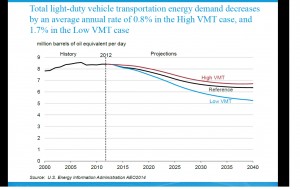Long accustomed to driving trends in U.S. society, the boomers may have met their match with the millennials–a generation (loosely defined as being between 18-33 or so, with some overlap with Gen-Xers, who are now in their mid-late 30s) that is changing attitudes about driving and car ownership. These changes have not received significant national attention as yet, but they have major implications for U.S. energy needs in the coming years.
As the boomers age and naturally drive less, the millennials are entering the stage when driving, measured by vehicle miles traveled, generally reaches its peak—but the historical patterns that have held true for the past 40 years aren’t being repeated today. In an analysis presented at the Energy Information Administration’s summer energy conference, Nancy McGuckin, a travel behavior analyst, showed that the number of miles traveled annually by drivers in the five age cohorts from 16-39 had declined by between 11 and 20 percent from 1995-2009. Because of that, VMT per licensed driver, which had risen steadily for decades prior to the 2000s, peaked in 2006-2007 and has been dropping since—falling from a high of 12,900 miles to about 12,500 in 2012 (figures are from EIA’s 2014 Annual Energy Outlook).

And there is no indication that the trend is going reverse itself anytime soon. Speaking at the same conference, Don Pickrell, an official with the Transportation Department’s Volpe Center, presented this fascinating graphic. Clearly, we are in uncharted waters—five years out from the end of the latest recession and per capita VMT is still well below pre-recession levels, with no indication it is going to start rising any time soon. In contrast, the five other recessions studied show strong recoveries—with VMT not only returning to their pre-recession levels, but rising well above by this point in the recovery.
The reasons are not yet definitive, but McGuckin, Pickrell and Trisha Hutchins, an analyst with EIA’s Office of Energy Consumption and Efficiency Analysis, all point to societal changes being driven by the millennials as a major factor in the current shift.
 Economic factors clearly are playing a role, the three said, pointing out that many millennials are saddled with students loans and have been hit particularly hard by the recession. At the same time, costs associated with owning and operating an automobile have gone up significantly in the past 10-20 years as the chart at left indicates—a bad combination at best for those trying to establish themselves.
Economic factors clearly are playing a role, the three said, pointing out that many millennials are saddled with students loans and have been hit particularly hard by the recession. At the same time, costs associated with owning and operating an automobile have gone up significantly in the past 10-20 years as the chart at left indicates—a bad combination at best for those trying to establish themselves.
But more than that, it appears that millennials don’t share the love affair with the “open road’’ that so many boomers grew up with—perhaps because the open road is really congested today. The number of highway/freeway miles in the U.S. has climbed from about 500,000 in 1975 to roughly 750,000 currently. This 50 percent increase, while significant, pales in comparison to the 85 percent increase in the number of registered vehicles during the same time period. With more than 250 million vehicles plying the nation’s highways today, the open road is anything but.
Another indicator that millennials may not share the boomers’ love affair with the automobile is the rise in the percentage of 25-29 year-olds that live in households without a car at all. In 1990, McGuckin reported, the number was less than 6 percent, but it has been rising steadily, particularly since 2000, and is now closing in on 8 percent. For a small, but growing segment of the population, owning a car clearly just isn’t that important.
In addition, millennials have a more open attitude toward mass transit. Using data from the Transportation Department’s 2009 national household travel survey, McGuckin reported that millennials take an average of 36 trips per capita on mass transit every year, compared to 30 for Gen-Xers and just 26 for boomers. Why is unclear, but McGuckin raised the following possibilities as potential answers: it is more social, better for the environment, cheaper, easier and allows for more “me’’ time.
Another key factor that is clearly influencing millennials’ behavior is the explosive growth of the internet and the development of the 24/7 online culture. The long-term impacts on automobile use are still unclear, but all three analysts offered examples of how developments in the past decade are changing travel patterns. The rise in online shopping, which has rocketed upward from less than $10 billion in annual sales in 2000 to almost $70 billion in 2013, will clearly cut the number of miles driven—every online purchase is essentially one less trip to the store.
Perhaps as important, McGuckin pointed to the way millennials use the internet to shop. More than 77 percent of them reported shopping/researching online before purchasing in the store. This total was almost 17 percent higher than the population as a whole and represents a new way of shopping—instead of driving from store to store in search of a good deal, millennials discover the best deal online and then drive to one store to pick up the item. Multiplied over many purchases and spread across a generation that is a lot fewer vehicles miles driven.
The three also raised the possibility that the millennials’ online culture might be serving as a substitute for travel. What that means long term is hard to say, but if socializing online replaces car trips to a coffee shop or nightclub you can see the possibility of major declines in the number of miles driven.
EIA has taken note of these shifts, cutting its forecast for VMT growth significantly in its 2014 energy outlook from the year before: The agency’s reference case estimate now shows VMT per licensed driver climbing at a rate of just 0.9 percent per year through 2040—almost half the 1.7 percent growth rate posted from 1995-2005 although still slightly higher than the recession-depressed 0.7 percent growth rate from 2005-2012.
Perhaps more interesting, the agency also offered up a “low VMT case’’ based on recent trends in miles traveled per licensed driver. In that case, growth in VMT is pegged at just 0.2 percent per year.
 The difference is important since so much of the nation’s oil consumption is tied to the transportation sector. With the major improvements in automotive fuel efficiency mandated by the Obama administration over the next two decades, EIA expects transportation-related oil consumption to fall no matter what, from today’s 8.4 million barrels per day (md/d) to under 6.5 mb/d in 2040. But under the low VMT scenario, oil consumption would fall even further, to an estimated 5.3 mb/d—a level not seen in decades.
The difference is important since so much of the nation’s oil consumption is tied to the transportation sector. With the major improvements in automotive fuel efficiency mandated by the Obama administration over the next two decades, EIA expects transportation-related oil consumption to fall no matter what, from today’s 8.4 million barrels per day (md/d) to under 6.5 mb/d in 2040. But under the low VMT scenario, oil consumption would fall even further, to an estimated 5.3 mb/d—a level not seen in decades.
–Dennis Wamsted
 Follow
Follow